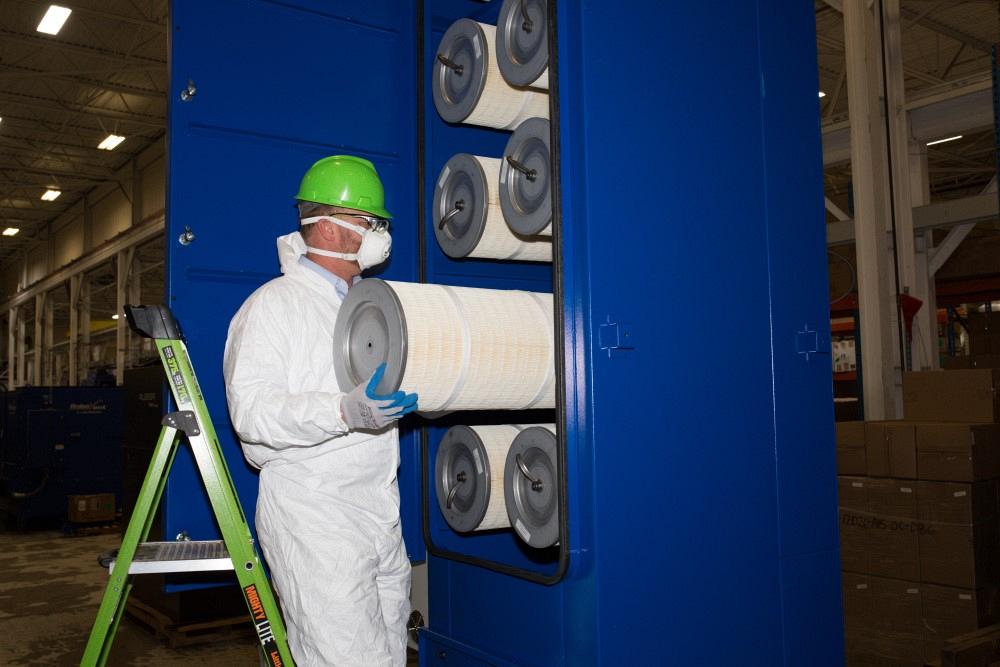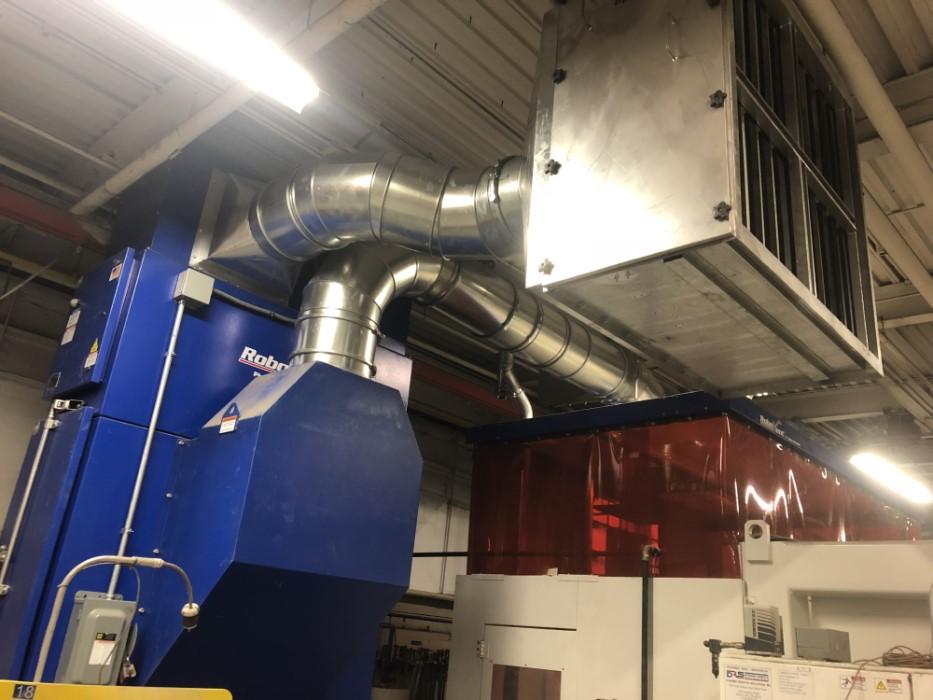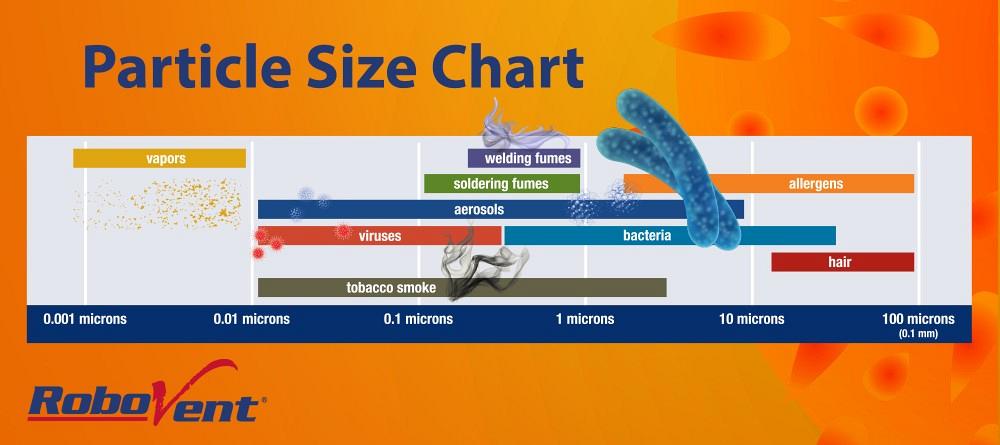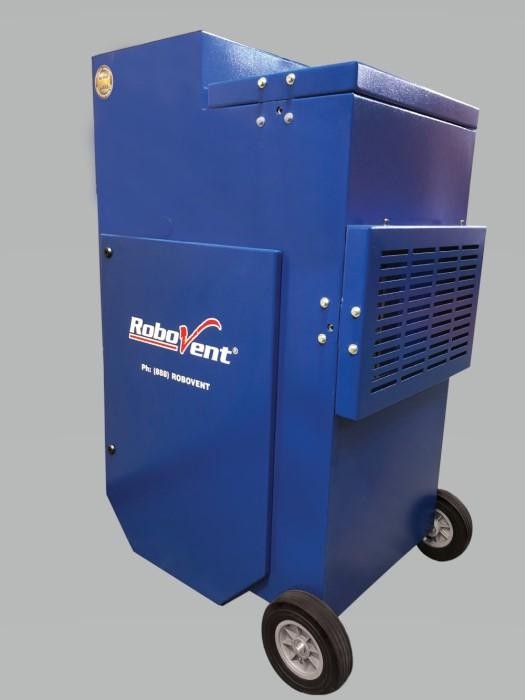president
- FMA
- The Fabricator
- FABTECH
- Canadian Metalworking
Categories
- Additive Manufacturing
- Aluminum Welding
- Arc Welding
- Assembly and Joining
- Automation and Robotics
- Bending and Forming
- Consumables
- Cutting and Weld Prep
- Electric Vehicles
- En Español
- Finishing
- Hydroforming
- Laser Cutting
- Laser Welding
- Machining
- Manufacturing Software
- Materials Handling
- Metals/Materials
- Oxyfuel Cutting
- Plasma Cutting
- Power Tools
- Punching and Other Holemaking
- Roll Forming
- Safety
- Sawing
- Shearing
- Shop Management
- Testing and Measuring
- Tube and Pipe Fabrication
- Tube and Pipe Production
- Waterjet Cutting
Industry Directory
Webcasts
Podcasts
FAB 40
Advertise
Subscribe
Account Login
Search
Addressing more than heavy air in the heavy fab shop
3 steps to protecting against COVID-19 with industrial air filtration systems
- By Rick Kreczmer
- October 25, 2021
- Article
- Safety

Maintenance personnel can change out filters on a robotic weld fume extractor and replace them with a MERV 15 filter that filters out COVID-19 pathogens.
Most manufacturers and heavy fabrication shops already have ventilation and air filtration systems in place to protect employees from dust and fumes that industrial processes create. Will those same systems help to reduce exposure to pathogens? What modifications are needed to reduce pathogen transmission? Upgrading ventilation and air filtration systems could help to slow the spread of diseases like COVID-19—and will offer ongoing benefits that go far beyond the pandemic.
COVID-19 and Industrial Air Quality
With the delta variant on the rise, COVID-19 is still very much a concern for employers. SARS-CoV-2 (the virus responsible for COVID-19), like the common cold, is primarily transmitted through respiratory droplets. As people talk and breathe, the virus is contained in microscopic droplets that travel through the air. A single cough may release more than 3,000 droplets; one sneeze releases more than 30,000 droplets and can travel up to 26 ft.
The Centers for Disease Control (CDC) and other scientific agencies have emphasized the importance of proper ventilation and air filtration as part of a layered approach to reducing the spread of COVID-19 (which may also include other measures such as masking, disinfection, and social distancing).
The goal of ventilation and air filtration for pathogen reduction is very similar to the goal for any other type of airborne contaminant: to reduce exposure below the level that can cause harm.
It takes more than a single SARS-CoV-2 virus to cause an infection. The chances that someone will get sick after being exposed to SARS-CoV-2, and how sick they end up being, are highly correlated to the amount of virus to which they are exposed.
That’s good news, because it means employers don’t have to worry about getting airborne virus levels down to zero. They just have to dilute the amount of virus in the air below the level of transmission. In a sense, this is no different from strategies already in place to reduce exposure to weld fumes and other airborne contaminants below the permissible exposure limit (PEL).
Existing ventilation, air filtration, and HVAC systems definitely can help, but they may require some modifications to increase their efficacy. A poorly implemented ventilation or filtration system could end up doing more harm than good.
ASHRAE has released COVID-19 guidance for different types of buildings. Because the manufacturing environment is complex, heavy fab shops and similar workplaces may want to consult an HVAC professional or industrial hygienist for help when making system adjustments.
Step 1: Ventilation and Room Refresh Rates

A dust collection system can be modified to include a HEPA afterfilter to provide advanced filtration for fine particulates including viruses and bacteria.
One simple way to dilute the amount of virus circulating in the air is to increase the overall air turnover rate (the rate at which all air in a room is replaced with fresh air). Some experts recommend increasing the turnover rate from about three to six changes per hour. There are several steps that you can take to achieve this.
- If the weather is accommodating, simply opening doors and windows can help.
- Consider increasing the ratio of fresh air to recycled air in your HVAC system and running the fan constantly, instead of only when the system is heating or cooling.
- Use your exhaust ventilation and makeup air system to pull air up and away from workers and return more fresh air to the facility.
Do consider how air circulates through the room and ensure that potentially contaminated air is being pulled away from workers, not toward them. Avoid creating strong air currents that pull air through the breathing zone.
Don’t recirculate air with ceiling fans. This may make things worse by pushing respiratory droplets back into the breathing zone and further spreading them through your space.
Be cautious about the use of room partitioning for virus protection. While partitions may be needed in fabrication shops for other reasons, recent research suggests that adding Plexiglas barriers between workstations is not an effective way to reduce the virus’s transmission. In fact, they may make things worse by reducing airflow and creating pockets where respiratory droplets can accumulate.
Calculators can help operations staff determine the appropriate refresh rates for their space.
Step 2: Upgrade Air Filtration
Your HVAC and industrial air filtration systems can help you increase air turnover rates and remove pathogens—but only with the right filtration. Air that will be returned to the facility must be filtered to avoid simply recirculating pathogens throughout the space.

This chart shows the particle size of various particulates. Viruses such as the coronavirus are submicron and are much smaller than welding fumes and other metalworking dusts and thus may require different types of air filters and filtration techniques.
Standard HVAC and dust collector filters will not remove viral pathogens. ASHRAE recommends a minimum filtration efficiency of MERV 13 to capture airborne pathogens like SARS-CoV-2.
- Some facilities may want to consider upgrading their HVAC filters to improve capture facility for pathogens.
- Ultraviolet (UV) germicidal radiation also can be used to disinfect air as it passes through the HVAC system.
With the right filtration, dust collection systems used for ambient (whole facility) filtration can supplement your HVAC system for pathogen capture (see lead image). Many dust collector filters are in the MERV 11 range, which is enough to filter metalworking dust and larger contaminants like pollen. If you want your dust collector to also filter out viruses, look for a dust collector cartridge filter with a MERV rating of 13 or above. If you are collecting weld fume, you should already have dust collector filters in this range.
- Look for high-quality materials, such as a cellulose polyester blend or a dense polyester spunbond substrate with a nanofiber or PTFE coating. Keep in mind that some off-brands may not deliver the filtration efficiency advertised or may lose filtration efficiency over time as microtears develop in the filter media.
- Make sure the filters are tightly fitted and the dust collector filter chamber is well sealed so that unfiltered air cannot escape back into the facility.
As an alternative, you may want to add HEPA afterfilters to your dust collector. HEPA filters must meet very high levels of filtration efficiency and are considered the gold standard for removal of very small particles, including viruses. They capture pathogens and ultrafine particulates that make it past the dust collector filters.
If your dust collector is used strictly for source capture of weld fumes or other contaminants from production processes, it may not be doing much to remove respiratory droplets from the facility as a whole. If you are not able to meet recommended air turnover rates with your HVAC system alone, you might consider adding portable air filtration units to your facility. Make sure these are positioned to pull air away from workers.
Do use filters with a MERV rating of 13 or above for virus capture.
Don’t return unfiltered air to the facility, as this will simply spread contamination to new areas.

Portable room cleaners and air purifiers with multiphase air filtration or other equipment help improve indoor air quality and supplement HVAC systems where proper indoor ventilation is not available.
Step 3: Personal Protection and Operational Controls
Industrial ventilation and air filtration are not adequate by themselves to prevent the spread of COVID-19 in your shop—especially in the face of the highly transmissible delta variant. People working in proximity to each other still can be exposed to respiratory droplets before they are collected and filtered by your HVAC or industrial filtration systems. To minimize transmission risk, ventilation and filtration should always be used as part of a layered strategy that also includes personal protection (masks), regular disinfection, and administrative controls.
Beyond COVID: The Benefits of Focusing on IAQ
Strategies for reducing pathogen transmission are just an extension of good industrial hygiene practices for indoor air quality (IAQ)—and the benefits extend far beyond COVID-19. Implementing these strategies will ensure that facilities remain in compliance with all IAQ standards and recommendations. They will also go a long way toward reducing sick days and creating a healthy, pleasant work environment for everyone.
Upgrading your ventilation and filtration game will provide ongoing benefits for you and your employees, including:
- Improved comfort and safety for employees.
- Reduction in air quality-related complaints such as headaches, nausea, and fatigue. Improved productivity and fewer missed workdays.
- Reduction in the spread of all kinds of pathogens—not just SARS-CoV-2.
If you have questions about indoor air quality and COVID-19, check out the ASHRAE resources or reach out to a qualified system engineer or industrial hygienist for help.
About the Author
Rick Kreczmer
37900 Mound Road
Sterling Heights, MI 48310
877-959-7639
Related Companies
subscribe now

The Fabricator is North America's leading magazine for the metal forming and fabricating industry. The magazine delivers the news, technical articles, and case histories that enable fabricators to do their jobs more efficiently. The Fabricator has served the industry since 1970.
start your free subscription- Stay connected from anywhere

Easily access valuable industry resources now with full access to the digital edition of The Fabricator.

Easily access valuable industry resources now with full access to the digital edition of The Welder.

Easily access valuable industry resources now with full access to the digital edition of The Tube and Pipe Journal.
- Podcasting
- Podcast:
- The Fabricator Podcast
- Published:
- 04/16/2024
- Running Time:
- 63:29
In this episode of The Fabricator Podcast, Caleb Chamberlain, co-founder and CEO of OSH Cut, discusses his company’s...
- Trending Articles
AI, machine learning, and the future of metal fabrication

Employee ownership: The best way to ensure engagement

Steel industry reacts to Nucor’s new weekly published HRC price

Dynamic Metal blossoms with each passing year

Metal fabrication management: A guide for new supervisors

- Industry Events
16th Annual Safety Conference
- April 30 - May 1, 2024
- Elgin,
Pipe and Tube Conference
- May 21 - 22, 2024
- Omaha, NE
World-Class Roll Forming Workshop
- June 5 - 6, 2024
- Louisville, KY
Advanced Laser Application Workshop
- June 25 - 27, 2024
- Novi, MI


























